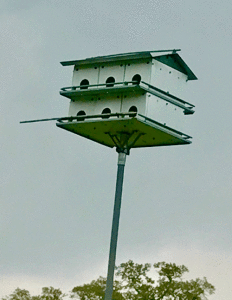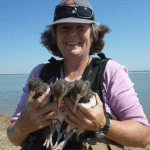
Purple Martin house
You know it’s just about spring when Purple Martin scouts arrive from their southern wintering grounds. Almost every year we received calls at the Gulf Coast Bird Observatory inquiring about Purple Martins, asking when they can be expected and why they send scouts ahead of the soon to arrive hordes.
Perhaps ‘scout’ is not the correct term and this is probably another case of humans and anthropomorphism. Adult Purple Martins arrive first and most often return to the same location as the previous year. These early arrivers have been called ‘scouts’ by some folks. They begin to arrive in our area just about now. We hope to see some soon flying around the Gulf Coast Bird Observatory singing and checking out the new house we put up this winter. The young birds or subadults arrive 6 weeks after the adults. We’ve never had them nest here on the GCBO grounds but we are ever hopeful that someday they will deem our habitat suitable and raise some babies here. They often take a few years of looking at a site before moving in. Purple Martins and humans have a long history of co-habitation. Due to cavity competition with introduced House Sparrows and European Starlings, eastern Purple Martins have been almost entirely dependent on human-made martin houses for nesting since the early 1900’s. Paradoxically, martins west of the Rocky Mountains still nest almost exclusively in old woodpecker holes or natural cavities. Few other species show such a marked geographic difference in nesting habits or have the long-standing relationship with humans that Purple Martins do.
The males are a beautiful glossy purple color all over while the females and young of the year are purplish on their backs and dusky underneath. They are quite entertaining as they glide, dip, and soar in search of flying insects. Although it is often advertised that they eat thousands of mosquitoes a day, there is no evidence that they actually eat them as mosquitoes usually fly lower than the typical foraging altitude of a martin. Still they make good neighbors feeding on other insects and entertaining us with their aerial prowess.
Purple Martins are the largest swallow in North America and should not be confused with our other swallow species. Birds nesting under bridges, especially highway overpasses, are typically Cliff or Cave Swallows which can be identified by the light patch on their upper tail. If you have swallows nesting in your porch eaves, they are most likely Barn Swallows which have long forked tails. All of these species make nests out of mud rather than using human-provided houses like Purple Martins.
There are many places in the area where you can see Purple Martins during the spring and summer including both rural and city environments as they will nest in most areas where the terrain is open enough. Martins show high site fidelity and will return year after year to the same nesting site if it is properly maintained although it may take several years for them to establish a colony in newly installed housing. Martins have very specific aerial space requirements and housing should be placed in the most open spot available with no nearby trees. Generally it needs to be at least 30 to 120 feet from human housing and there should be no trees taller than the housing within 40 feet. As we have learned at GCBO, patience is key to being a successful Purple Martin landlord. If you want more information about Purple Martins, check out the Purple Martin Conservation Association’s webpage. www.purplemartin.org
 Sue Heath is the Director of Conservation Research of the Gulf Coast Bird Observatory. The GCBO is a non-profit organization dedicated to saving the birds and their habitats along the entire Gulf Coast, and beyond into their Central and South America wintering grounds.
Sue Heath is the Director of Conservation Research of the Gulf Coast Bird Observatory. The GCBO is a non-profit organization dedicated to saving the birds and their habitats along the entire Gulf Coast, and beyond into their Central and South America wintering grounds.
